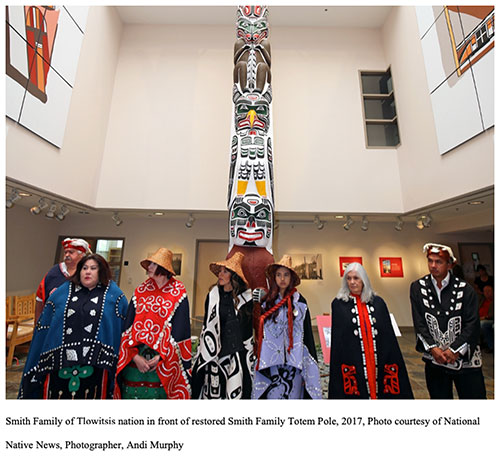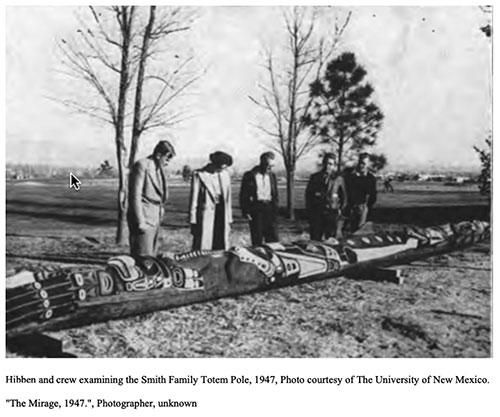
The Smith Family Totem Pole
1907
THE SMITH FAMILY TOTEM POLE (1907 to present) is a striking installation students and staff might pass by daily in the Hibben Anthropology Annex. While seemingly innocuous, the pole has a secret and dramatic history, involving theft and a controversial young Anthropology professor. The totem pole represents a captivating cinematic heist but also is a physical symbol of the queasy, sometimes problematic relationship the University has shared historically with indigenous populations.

The Smith Family Totem Pole is a culturally significant piece commissioned in 1907 by the Smith Family of the Tlowitsis Nation in British Columbia in 1907. It originally came to be in the possession of the University of New Mexico in 1941 through illegal means carried out by former anthropology Professor Frank Hibben. Once the University learned of the true nature of the totem pole they set forth to right this error with the Smith Family. Since then the totem pole has been restored and relocated to Maxwell Museum on campus to better preserve its integrity. Agreements have been made with the Smith Family to allow UNM to house the totem pole and a replica of the pole will be erected in its original location in British Columbia.
Noted artist, Yakwuλas, carved seven crest animals into a 40-foot tall, one-ton totem pole. He was commissioned by the Chief of the Tlowitsis in 1907 on the Island in British Columbia; home to the aboriginal village of the Tlowitsis Nation. The crest figures he created are a visual representation of the Chief’s kinship with his ancestors and serve as authentication to his authority as Chief.[1] The Chief erected the pole in front of his home in order to be visible to the community.
In the summer of 1941, the pole vanished. That same summer, a young assistant professor from UNM’s Anthropology Department, Frank Hibben, traveled from the Southwest to the Pacific Northwest to conduct research but also, to acquire a totem pole for the University of New Mexico. The New Mexico Lobo reported the trip to be “adventure filled” and “a vacation...but devoted to the collection of materials for UNM’s exhibits”.[2] The reasons the University wanted this piece of non-local material culture is unclear. It seems likely it was desirable as a piece of public art to establish UNM as a credible university. The University agreed upon a discretionary budget to pay for freight back to Albuquerque. Hibben claimed that he purchased this irreplaceable cultural artifact from the Tlowitsis Nation for two cases of whiskey.[3] The Tlowitsis Nation tells a very different story. Hibben offered to purchase the pole and was rebuffed. The Tlowitsis migrate seasonally to different villages. They returned to their village to find the pole gone and filed a report with the Canadian Police.
Hibben towed the totem pole behind his boat to Alaska, passing the U.S.-Canadian border by misrepresenting the pole as Tlingit people made. From there, he put the pole on a freighter to Seattle and then finally on a flat train car to Albuquerque. The University received the totem pole ostensibly unaware that it was a stolen object.
In 2012, UNM Anthropology professor, Beverly Singer, conducted a study on the pole with a focus on preservation. What she uncovered was the disturbing history of how the artifact came to be in the University’s possession. The University has made public attempts to make amends for their apparent oversight.
UNM contacted the Smith family noting them as the rightful owners. The family did not wish for the pole to be returned but rather that it be restored to its former glory as well as be represented correctly for the heritage it stands for. They also requested that a replica of the pole eventually be erected where the original previously stood in Tlowitsis nation.
UNM completed the restoration of the totem pole in May of 2017 after three long weeks of difficult and precise work by master carvers Tom Hunt Jr. and his apprentice, Bertram Smith. In September 2017, the Smith family traveled to Albuquerque to bless the pole at its unveiling ceremony; the pole now erected inside the Hibben Anthropology Annex of Maxwell Museum. At the ceremony Chaouki Abdallah, Interim President of the University of New Mexico, addressed the Smith family directly and apologized for the University’s involvement in the retrieval of the pole while also acknowledging its significance and culturally important background. He directly acknowledged the university’s past mistakes and expresses his wishes to move forward.
Chief Danial Smith in turn addressed the crowd, expressing the happiness and gratitude he and his family felt following the union with the University and the restoration of the totem pole. Fundraising has been established by Maxwell Museum and the UNM Anthropology Department for the creation of the replica Smith Family Totem Pole.
Aidan Miolano, Anthropology, 2020
Marianne Merz, English, 2021
Further Reading:
Hooker, Van Dorn and Melissa Howard. Only in New Mexico: An Architectural History of the University of New Mexico : the First Century, 1889-1989. New Mexico: UNM Press, 2000.
Phillips, David. “The Smith Family Totem Pole,” The Maxwell 48, no. 1 (Spring 2018): 3–6.
UNM Faculty Senate. "Faculty Senate Meeting Minutes, 12/09/1946, vol 5, p204 221." 1946). digitalrepository.unm.edu/ fs_minutes/193
University of New Mexico. "New Mexico Lobo, Volume 062, No 69, 4/17/1959." 62, 69 (1959). digitalrepository.unm.edu daily_lobo_1959/33
